Regional Forest Mapping over Mountainous Areas in Northeast China Using Newly Identified Critical Temporal Features of Sentinel-1 Backscattering
Abstract
1. Introduction
2. Study Area and Data Preparation
2.1. Study Area
2.2. Sentinel-1 Data Preprocessing
2.3. Reference Data Collecting
2.3.1. Sampling Plots for Observations of Temporal Behaviors
2.3.2. Sampling Plots for the Retrieval of Forest Canopy Coverage
2.3.3. Sampling Plots for Forest/Non-Forest Map Validation
2.4. Meteorological Data
2.5. Forest Maps Derived from Publicly Released Land Cover Maps
2.5.1. ALOS PALSAR Forest/Non-Forest Map
2.5.2. Global Forest Cover Change (GFCC)
2.5.3. Finer Resolution Observation and Monitoring of Global Land Cover (FROM-GLC)
3. Temporal Behavior of Sentinel-1 Backscattering Coefficients over Forest and Non-Forest Plots
- (1)
- The date when the largest drop of backscattering coefficients over non-forest plots coincides with the date when the daily minimum temperature decreases across the freezing point; the decreased magnitude over non-forest plots is larger than that over forest plots.
- (2)
- The date when the largest drop of backscattering coefficients over forest plots coincides with the date when the daily maximum temperature decreases across the freezing point; the decreased magnitude over non-forest plots is smaller than that over forest plots.
- (3)
- The decreased magnitude of backscattering coefficients when the daily minimum temperature decreases across the freezing point is negatively correlated with forest canopy coverage, while that when the daily maximum temperature decreases across the freezing point is positively correlated with forest canopy coverage.
4. Methods for Regional Forest Mapping
4.1. Direct Method for Forest Mapping
4.2. Indirect Method for Forest Mapping via Canopy Coverage
4.3. Assessment of Forest Maps
5. Results
5.1. Intermediate Results of the Direct Method
5.2. Intermediate Results of the Indirect Method
5.3. Assessments of Forest Maps
6. Discussion
6.1. Specific Features of C-Band Backscattering during the Transition from Autumn to Winter
6.2. Significance of Date2 for Forest Mapping Using Sentinel-1 Images
6.3. Further Exploration for Physical Understanding of the New Findings
6.4. Terrain Effects
6.5. Latitude and Precipitation Effects
7. Conclusions
Author Contributions
Funding
Acknowledgments
Conflicts of Interest
References
- Stenger, A.; Harou, P.; Navrud, S. Valuing Environmental Goods and Services Derived from the Forests. J. For. Econ. 2010, 15, 1–14. [Google Scholar] [CrossRef]
- Martone, M.; Rizzoli, P.; Wecklich, C.; Gonzalez, C.; Bueso-Bello, J.L.; Valdo, P.; Schulze, D.; Zink, M.; Krieger, G.; Moreira, A. The global forest/non-forest map from TanDEM-X interferometric SAR data. Remote Sens. Environ. 2018, 205, 352–373. [Google Scholar] [CrossRef]
- Le Toan, T.; Quegan, S.; Davidson, M.; Balzter, H.; Paillou, P.; Papathanassiou, K.; Plummer, S.; Rocca, F.; Saatchi, S.; Shugart, H. The BIOMASS mission: Mapping global forest biomass to better understand the terrestrial carbon cycle. Remote Sens. Environ. 2011, 115, 2850–2860. [Google Scholar] [CrossRef]
- Bartholome, E.; Belward, A.S. GLC2000: A new approach to global land cover mapping from Earth observation data. Int. J. Remote Sens. 2005, 26, 1959–1977. [Google Scholar] [CrossRef]
- Bontemps, S.; Defourny, P.; Bogaert, E.V.; Arino, O.; Kalogirou, V.; Perez, J.R. GlobCover 2009—Product Description Manual; ESA: Paris, France, 2011. [Google Scholar]
- Chen, J.; Chen, J.; Liao, A.; Cao, X.; Chen, L.; Chen, X.; He, C.; Han, G.; Peng, S.; Lu, M. Global land cover mapping at 30 m resolution: A POK-based operational approach. ISPRS J. Photogramm. Remote. Sens. 2015, 103, 7–27. [Google Scholar] [CrossRef]
- Gong, P.; Wang, J.; Yu, L.; Zhao, Y.; Zhao, Y.; Liang, L.; Niu, Z.; Huang, X.; Fu, H.; Liu, S. Finer resolution observation and monitoring of global land cover: First mapping results with Landsat TM and ETM+ data. Int. J. Remote Sens. 2013, 34, 2607–2654. [Google Scholar] [CrossRef]
- Hansen, M.C.; Potapov, P.V.; Moore, R.; Hancher, M.; Turubanova, S.A.; Tyukavina, A.; Thau, D.; Stehman, S.V.; Goetz, S.J.; Loveland, T.R. High-resolution global maps of 21st-century forest cover change. Science 2014, 342, 850–853. [Google Scholar] [CrossRef]
- Rüetschi, M.; Schaepman, M.E.; Small, D. Using Multitemporal Sentinel-1 C-band Backscatter to Monitor Phenology and Classify Deciduous and Coniferous Forests in Northern Switzerland. Remote. Sens. 2017, 10. [Google Scholar]
- Mohammadimanesh, F.; Salehi, B.; Mahdianpari, M.; Brisco, B.; Motagh, M. Multi-temporal, multi-frequency, and multi-polarization coherence and SAR backscatter analysis of wetlands. ISPRS J. Photogramm. Remote. Sens. 2018, 142, 78–93. [Google Scholar] [CrossRef]
- Quegan, S.; Rhodes, I. Statistical-Models for Polarimetric Data - Consequences, Testing and Validity. Int. J. Remote Sens. 1995, 16, 1183–1210. [Google Scholar] [CrossRef]
- Kimes, D.S.; Ranson, K.J.; Sun, G. Inversion of a forest backscatter model using neural networks. Int. J. Remote Sens. 1997, 18, 2181–2199. [Google Scholar] [CrossRef]
- Askne, J.I.H.; Dammert, P.B.G.; Ulander, L.M.H.; Smith, G. C-band repeat-pass interferometric SAR observations of the forest. IEEE Trans. Geosci. Remote Sens. 1997, 35, 25–35. [Google Scholar] [CrossRef]
- Chen, K.S.; Huang, W.P.; Tsay, D.H.; Amar, F. Classification of multifrequency polarimetric SAR imagery using a dynamic learning neural network. IEEE Trans. Geosci. Remote Sens. 1996, 34, 814–820. [Google Scholar] [CrossRef]
- Hoekman, D.H.; Quinones, M.J. Land cover type and biomass classification using AirSAR data for evaluation of monitoring scenarios in the Colombian Amazon. In Proceedings of the 2nd International Workshop on Retrieval of Bio- and Geophysical parameters from SAR data for land applications, Noordwijk, The Netherlands, 21–23 October 1998; pp. 215–223. [Google Scholar]
- Ranson, K.J.; Sun, G.Q. An evaluation of AIRSAR and SIR-C/X-SAR images for mapping northern forest attributes in Maine, USA. Remote Sens. Environ. 1997, 59, 203–222. [Google Scholar] [CrossRef]
- Degrandi, G.F.; Lemoine, G.G.; Degroof, H.; Lavalle, C.; Sieber, A.J. Fully Polarimetric Classification of the Black-Forest Maestro-1 Airsar Data. Int. J. Remote Sens. 1994, 15, 2755–2775. [Google Scholar] [CrossRef]
- Townsend, P.A. Mapping seasonal flooding in forested wetlands using multi-temporal radarsat SAR. Photogramm. Eng. Remote Sens. 2001, 67, 857–864. [Google Scholar]
- Conway, J. Evaluating ERS-1 SAR data for the discrimination of tropical forest from other tropical vegetation types in Papua New Guinea. Int. J. Remote Sens. 1997, 18, 2967–2984. [Google Scholar] [CrossRef]
- Quegan, S.; Le Toan, T.; Yu, J.J.; Ribbes, F.; Floury, N. Multitemporal ERS SAR analysis applied to forest mapping. IEEE Trans. Geosci. Remote Sens. 2000, 38, 741–753. [Google Scholar] [CrossRef]
- Proisy, C.; Mougin, E.; Dufrêne, E.; Dantec, V.L. Monitoring seasonal changes of a mixed temperate forest using ERS SAR observations. IEEE Trans. Geosci. Remote Sens. 2000, 38, 540–552. [Google Scholar] [CrossRef]
- Ulaby, F.T.; Moore, R.K.; Fung, A.K.; Rasool, S.I. Book-Review—Microwave Remote Sensing—Active and Passive. Space. Sci. Rev. 1983, 35, 295. [Google Scholar]
- Pulliainen, J.T.; Mikkela, P.J.; Hallikainen, M.T.; Ikonen, J.P. Seasonal dynamics of C-band backscatter of boreal forests with applications to biomass and soil moisture estimation. IEEE Trans. Geosci. Remote Sens. 1996, 34, 758–770. [Google Scholar] [CrossRef]
- Balzter, H. Forest mapping and monitoring with interferometric synthetic aperture radar (InSAR). Prog. Phys. Geogr. 2001, 25, 159–177. [Google Scholar] [CrossRef]
- Song, Y.; Wang, J. Mapping Winter Wheat Planting Area and Monitoring Its Phenology Using Sentinel-1 Backscatter Time Series. Remote Sens. 2019, 11. [Google Scholar] [CrossRef]
- Nasrallah, A.; Baghdadi, N.; El Hajj, M.; Darwish, T.; Belhouchette, H.; Faour, G.; Darwich, S.; Mhawej, M. Sentinel-1 Data for Winter Wheat Phenology Monitoring and Mapping. Remote Sens. 2019, 11, 2228. [Google Scholar] [CrossRef]
- Huang, W.; Hu, Y.; Chang, Y.; Liu, M.; Li, Y.; Ren, B.; Shi, S. Effects of Fire Severity and Topography on Soil Black Carbon Accumulation in Boreal Forest of Northeast China. Forests 2018, 9, 408. [Google Scholar] [CrossRef]
- Attema, E.; Bargellini, P.; Edwards, P.; Levrini, G.; Lokas, S.; Moeller, L.; Rosichtell, B.; Secchi, P.; Torres, R.; Davidson, M. Sentinel-1-the radar mission for GMES operational land and sea services. Esa Bull. 2007, 131, 10–17. [Google Scholar]
- Nagler, T.; Rott, H.; Hetzenecker, M.; Wuite, J.; Potin, P. The Sentinel-1 Mission&58; New Opportunities for Ice Sheet Observations. Remote Sens. 2015, 7, 9371. [Google Scholar]
- Sun, G.; Ranson, K.J.; Kharuk, V.I. Radiometric slope correction for forest biomass estimation from SAR data in the Western Sayani Mountains, Siberia. Remote Sens. Environ. 2002, 79, 279–287. [Google Scholar] [CrossRef]
- Ohtsu, N. A Threshold Selection Method from Gray-Level Histograms. IEEE Trans. Syst. Man. Cybern. 2007, 9, 62–66. [Google Scholar] [CrossRef]
- Rose, S. Forests and Climate Change Working Paper 10. Tech. Rep. 2012, 11, 269–272. [Google Scholar]
- Shimada, M.; Itoh, T.; Motooka, T.; Watanabe, M.; Thapa, R. Generation of the first PALSAR-2 global mosaic 2014/2015 and change detection between 2007 and 2015 using the PALSAR and PALSAR-2. In Proceedings of the Geoscience and Remote Sensing Symposium, Beijing, China, 10–15 July 2016; pp. 3871–3872. [Google Scholar]
- Shimada, M.; Itoh, T.; Motooka, T.; Watanabe, M.; Shiraishi, T.; Thapa, R.; Lucas, R. New global forest/non-forest maps from ALOS PALSAR data (2007–2010). Remote Sens. Environ. 2014, 155, 13–31. [Google Scholar] [CrossRef]
- Ulaby, F.T.; Moore, R.K.; Fung, A.K. Microwave Remote Sensing: Active and Passive v.2: Radar Remote Sensing and Surface Scattering and Emission Theory; Addison-Wesley Pub. Co: Boston, MA, USA, 1982. [Google Scholar]
- Rignot, E.J.M.; Williams, C.L.; Way, J.B.; Viereck, L.A. Mapping of Forest Types in Alaskan Boreal Forests Using Sar Imagery. IEEE Trans. Geosci. Remote Sens. 1994, 32, 1051–1059. [Google Scholar] [CrossRef]
- Way, J.; Rignot, E.J.M.; Mcdonald, K.C.; Oren, R.; Kwok, R.; Bonan, G.; Dobson, M.C.; Viereck, L.A.; Roth, J.E. Evaluating the Type and State of Alaska Taiga Forests with Imaging Radar for Use in Ecosystem Models. IEEE Trans. Geosci. Remote Sens. 1994, 32, 353–370. [Google Scholar] [CrossRef]
- Wang, Y.; Kasischke, E.S.; Melack, J.M.; Davis, F.W.; Christensen, N.L. The Effects of Changes in Loblolly-Pine Biomass and Soil-Moisture on Ers-1 Sar Backscatter. Remote Sens. Environ. 1994, 49, 25–31. [Google Scholar] [CrossRef]
- Ranson, K.J.; Saatchi, S.; Sun, G.Q. Boreal forest ecosystem characterization with SIR-C/XSAR. IEEE Trans. Geosci. Remote Sens. 1995, 33, 867–876. [Google Scholar] [CrossRef]
- Belenguer-Plomer, M.A.; Tanase, M.A.; Fernandez-Carrillo, A.; Chuvieco, E. Burned area detection and mapping using Sentinel-1 backscatter coefficient and thermal anomalies. Remote Sens. Environ. 2019, 233. [Google Scholar] [CrossRef]
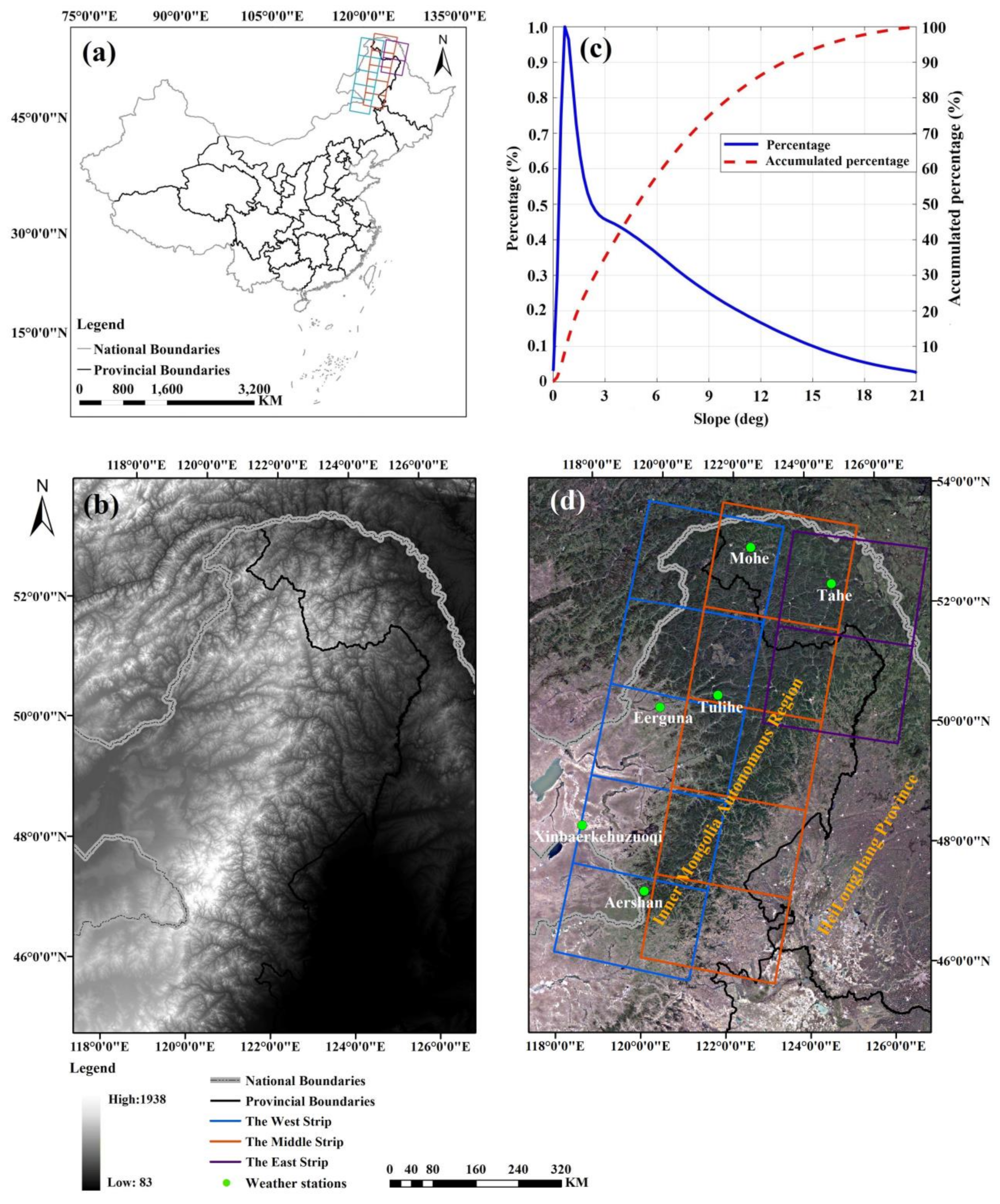


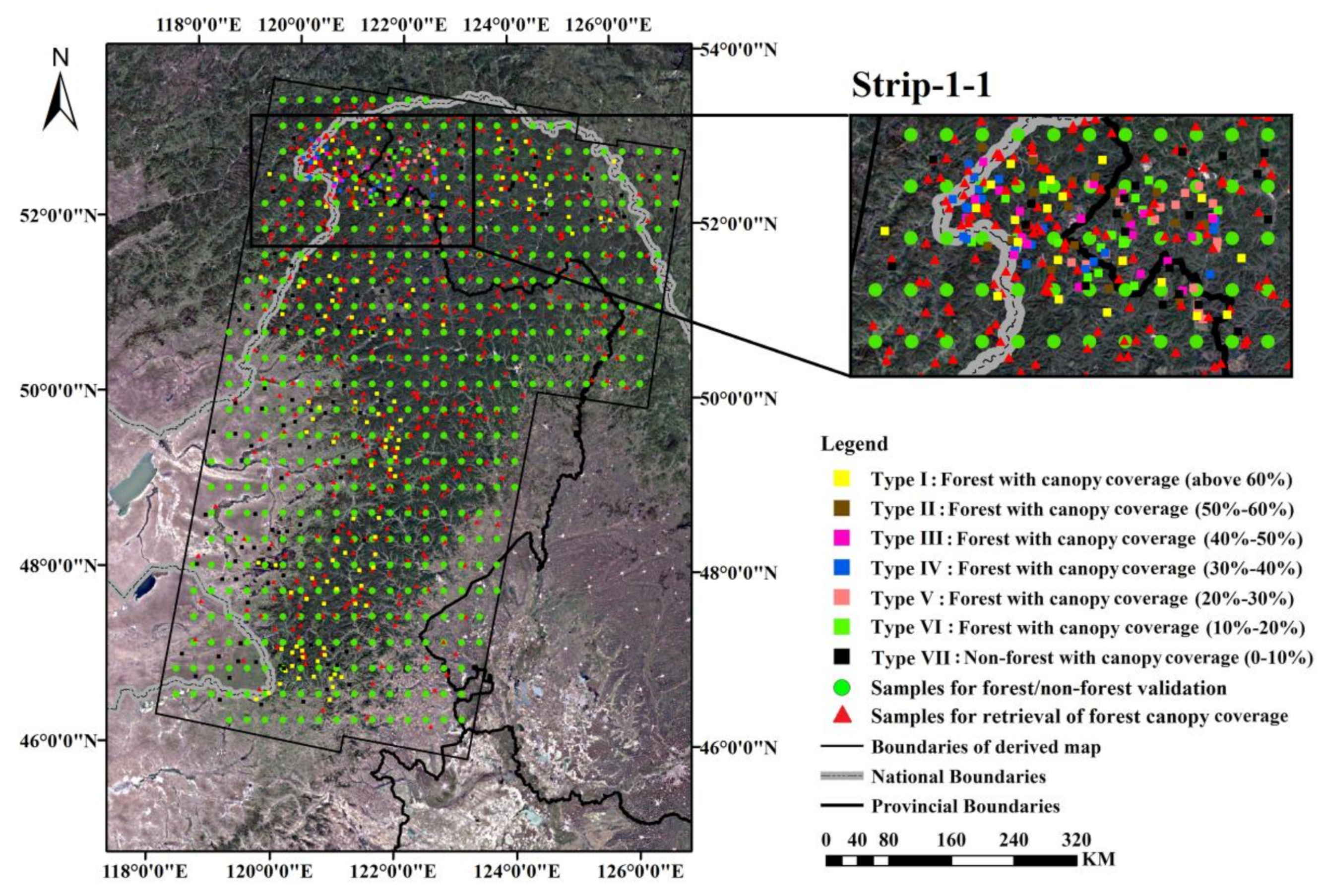
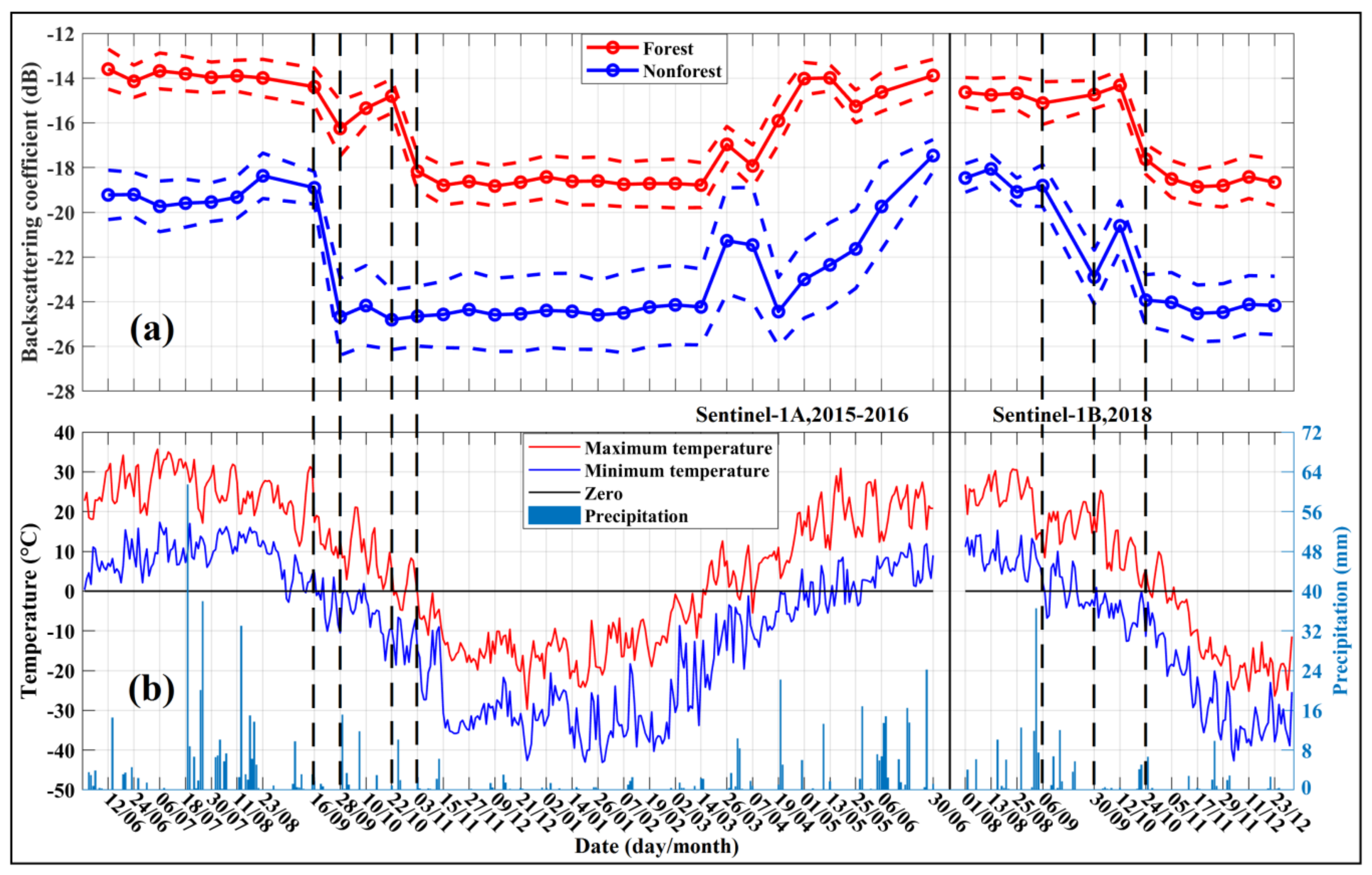
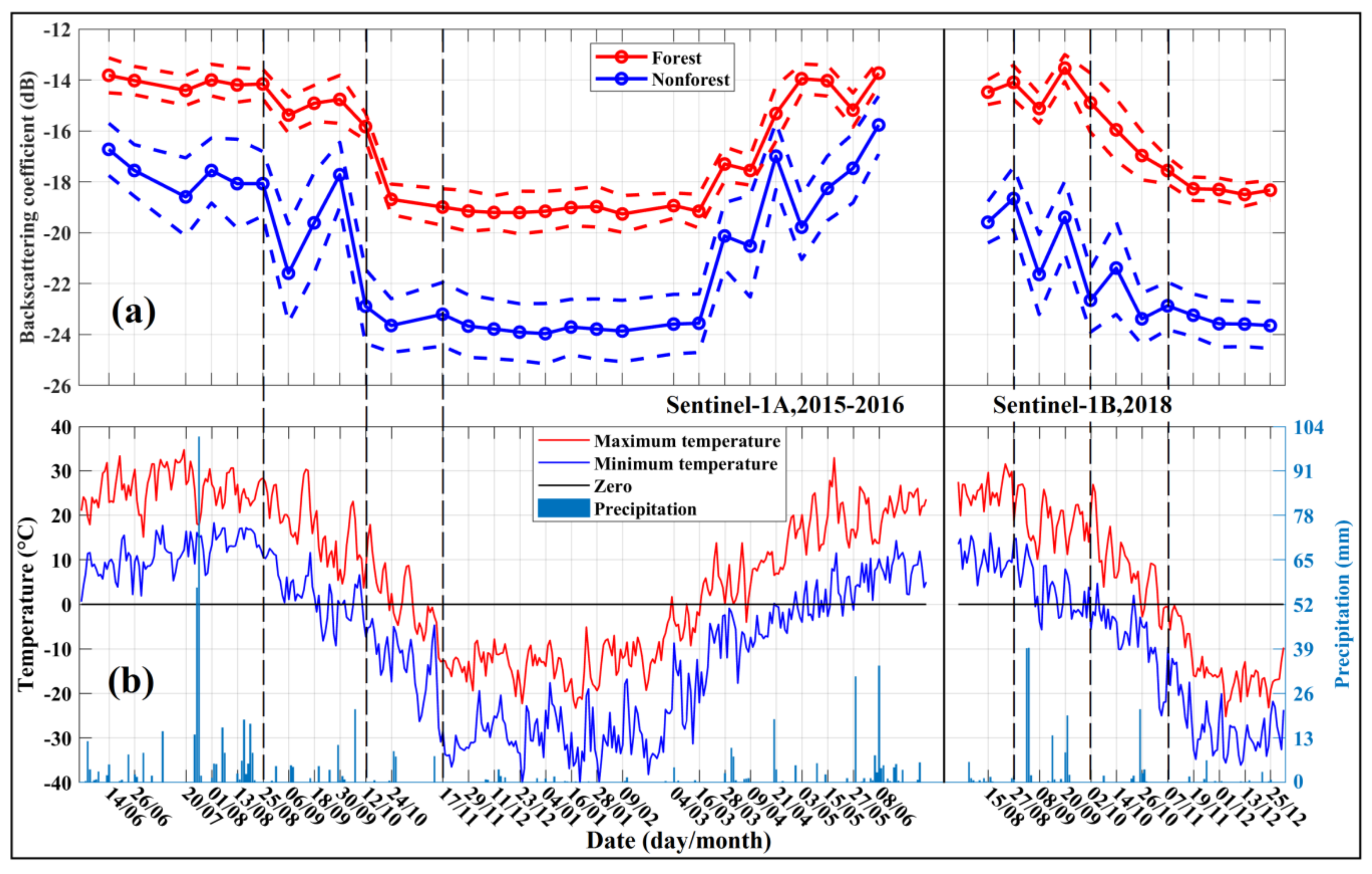


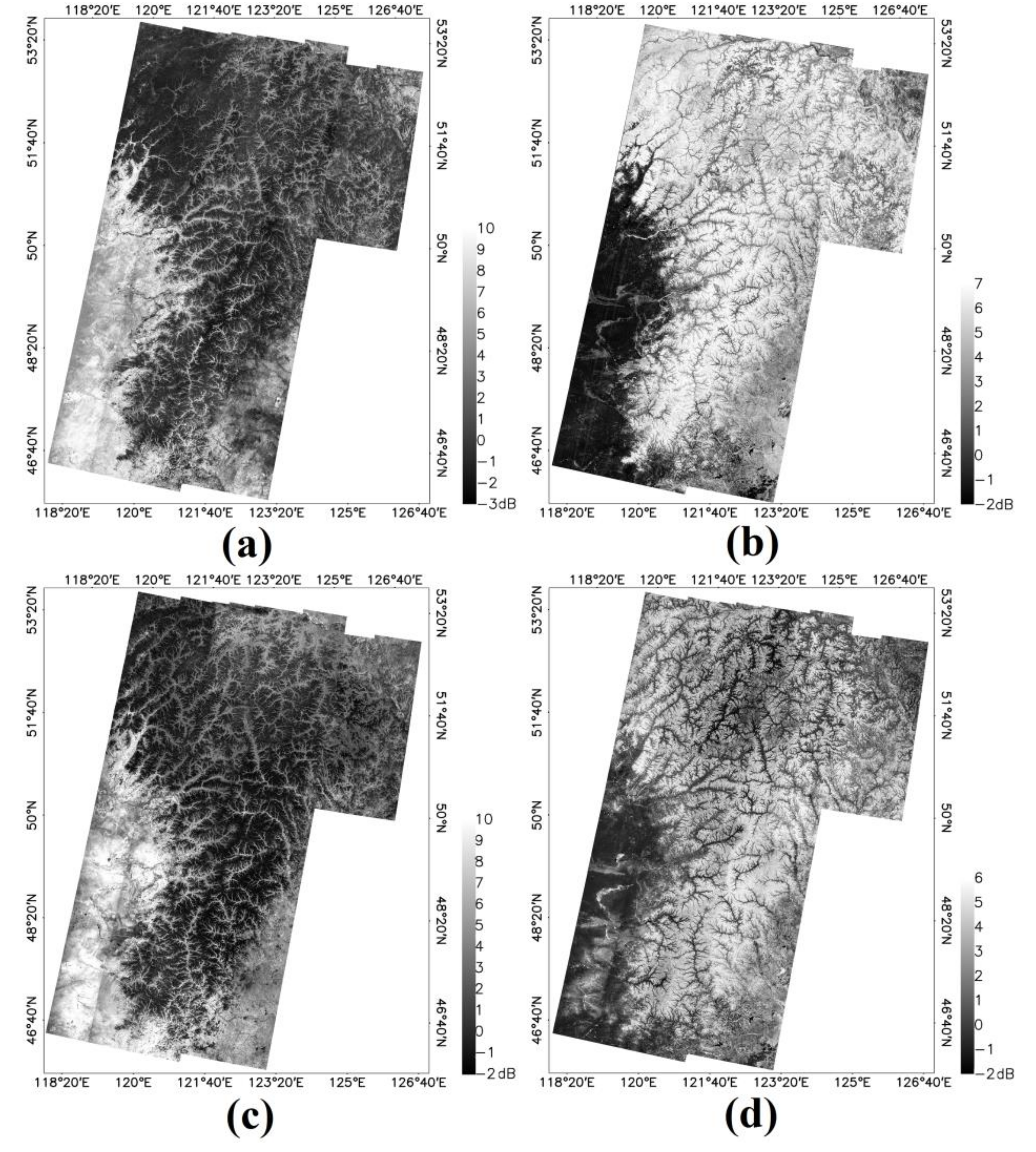
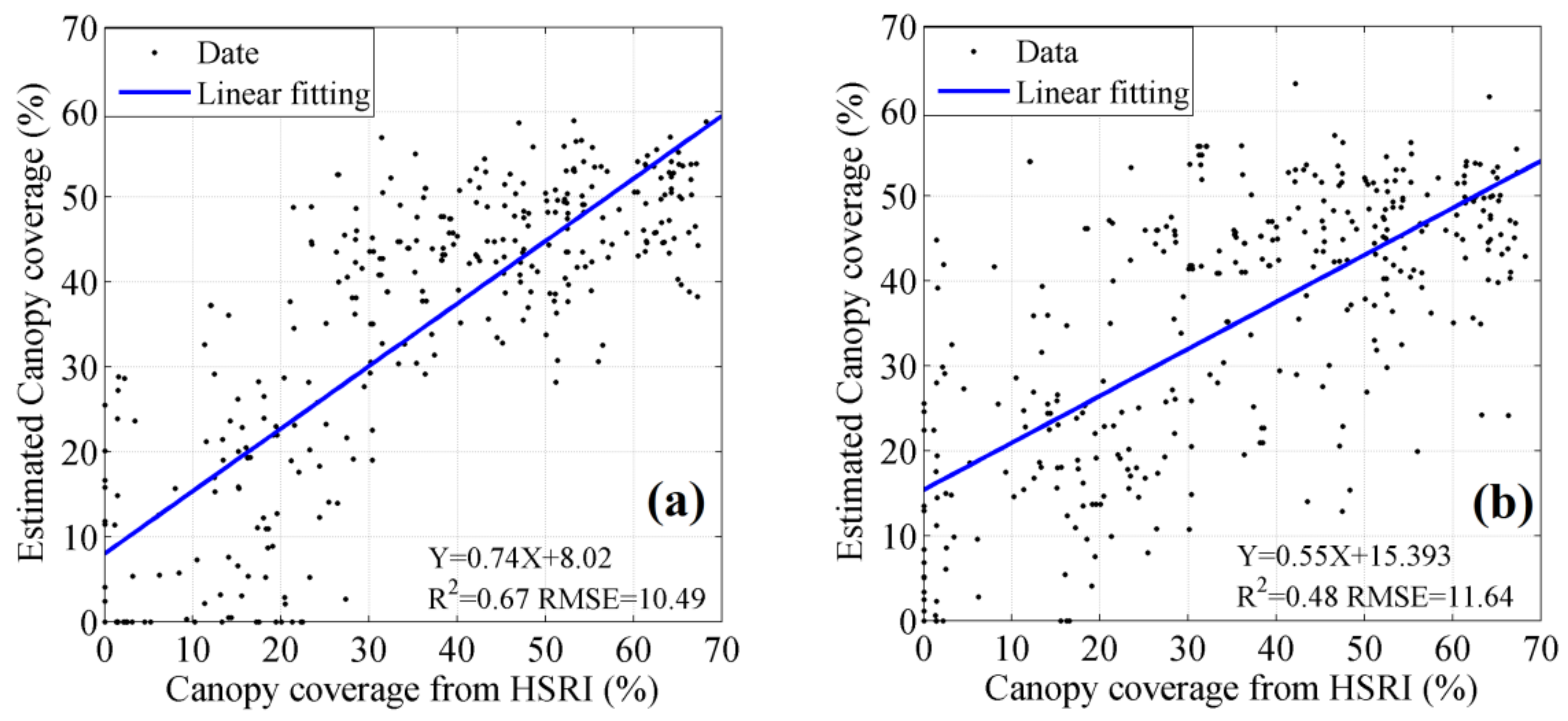
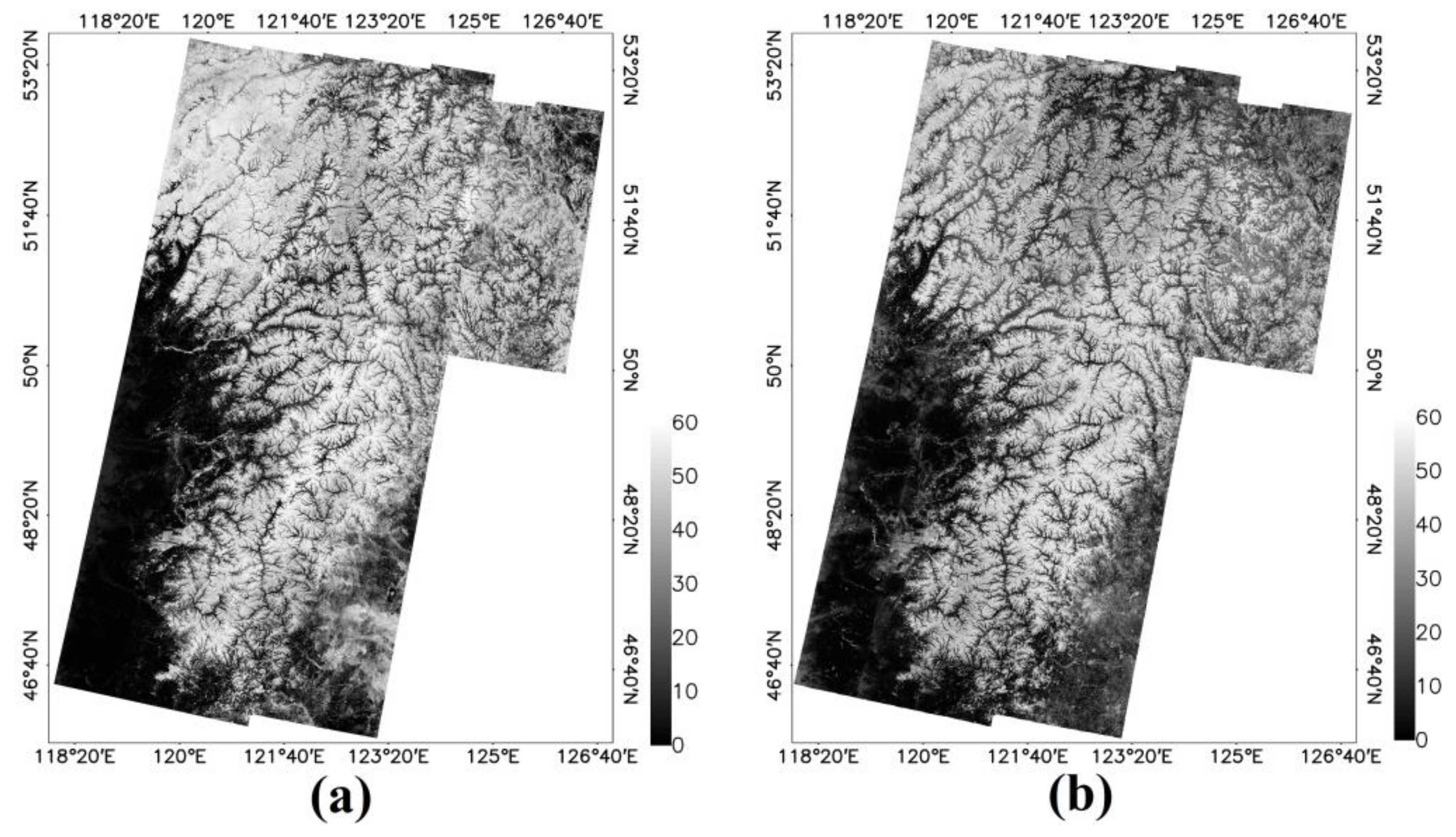
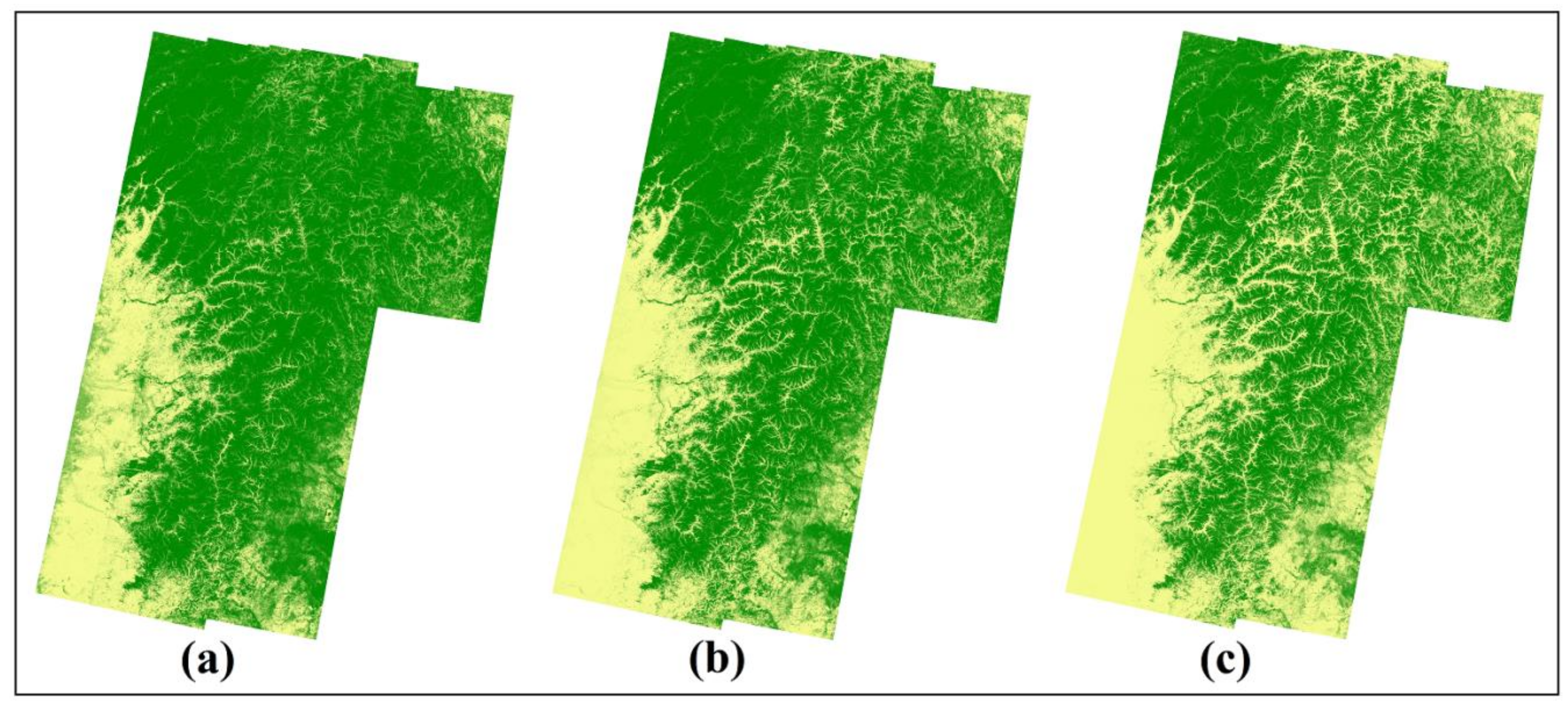
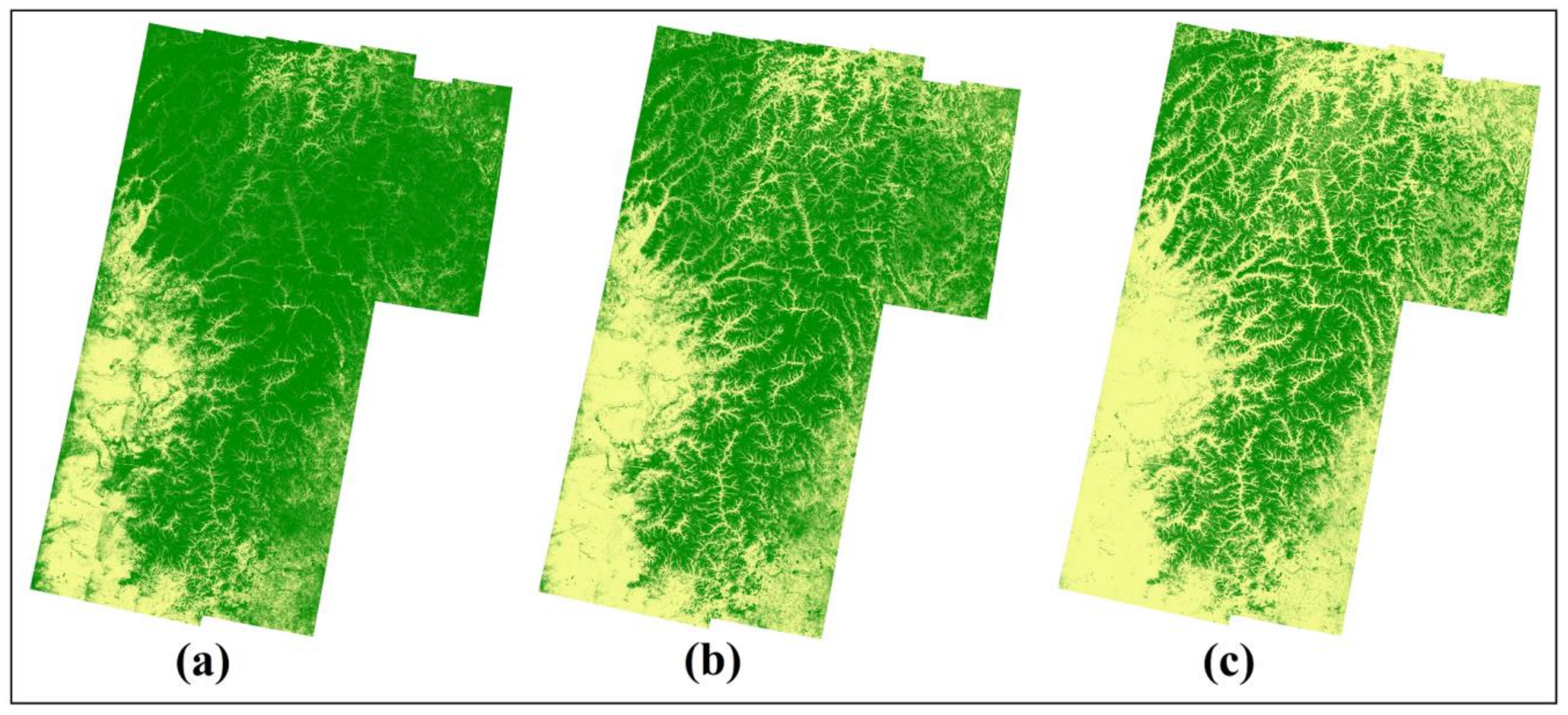
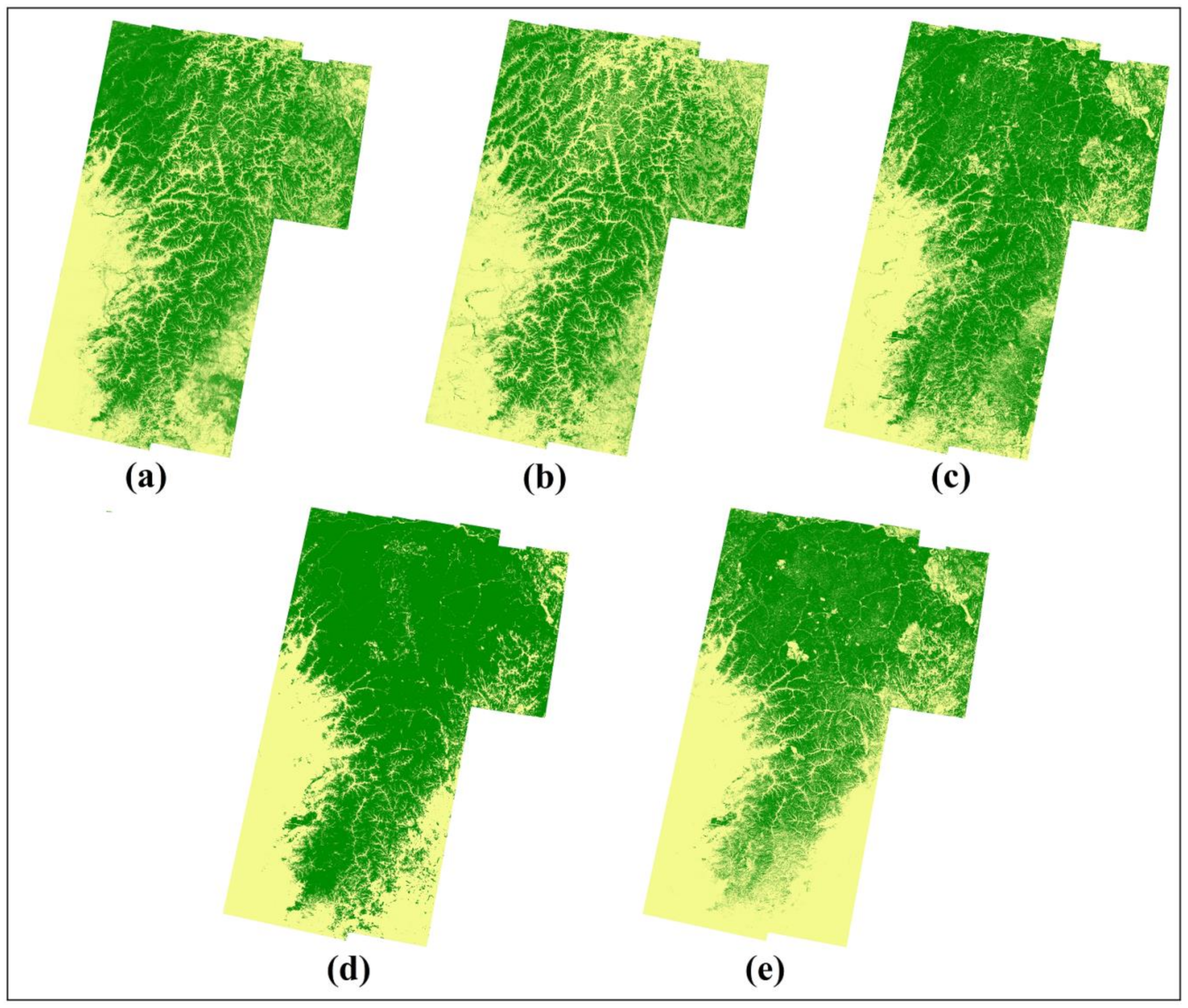
| Year/Satellite | Scene | Date1 | Date2 | Date3 |
|---|---|---|---|---|
| 2015/Sentinel-1A | West Strip | August 23rd 2015 | October 22nd 2015 | November 15th 2015 |
| Middle Strip | July 25th 2015 | October 5th 2015 | November 10th 2015 | |
| East Strip | August 25th 2015 | October 12th 2015 | November 17th 2015 | |
| 2018/Sentinel-1B | West Strip | August 13th 2018 | September 30th 2018 | December 23rd 2018 |
| Middle Strip | September 1st 2018 | October 19th 2018 | December 18th 2018 | |
| East Strip | August 27th 2018 | October 2nd 2018 | December 25th 2018 |
| Model | Variable | Equation1 | R2 | RMSE |
|---|---|---|---|---|
| Model_2015 | Combination | 0.64 | 10.41% | |
| Model_2018 | Combination | 0.53 | 12.03% |
| Maps | F1 | N2 | Total | PA (%) | Maps | F | N | Total | PA (%) | ||
|---|---|---|---|---|---|---|---|---|---|---|---|
| model_2015 >10% | F | 288 | 37 | 325 | 88.62 | Direct method using data of 2015 | F | 261 | 3 | 264 | 98.86 |
| N | 1 | 158 | 159 | 99.37 | N | 28 | 192 | 220 | 87.27 | ||
| UA (%) | 99.65 | 81.03 | / | OA: 92.15 | UA (%) | 90.31 | 98.46 | / | OA: 93.60 | ||
| model_2015 >20% | F | 280 | 21 | 299 | 93.65 | Direct method using data of 2018 | F | 248 | 16 | 264 | 93.94 |
| N | 9 | 174 | 185 | 94.05 | N | 41 | 179 | 220 | 81.36 | ||
| UA (%) | 96.89 | 89.23 | / | OA: 93.80 | UA (%) | 85.81 | 91.79 | / | OA: 88.22 | ||
| model_2015 >30% | F | 257 | 5 | 262 | 98.09 | FROM-GLC | F | 275 | 28 | 303 | 90.76 |
| N | 32 | 190 | 222 | 85.59 | N | 14 | 167 | 181 | 92.27 | ||
| UA (%) | 88.93 | 97.44 | / | OA: 92.36 | UA (%) | 95.16 | 85.64 | / | OA: 91.32 | ||
| model_2018 >10% | F | 287 | 46 | 333 | 86.19 | ALOS/PALSAR | F | 283 | 21 | 304 | 93.09 |
| N | 2 | 149 | 151 | 98.68 | N | 6 | 174 | 180 | 96.67 | ||
| UA (%) | 99.31 | 76.41 | / | OA: 90.08 | UA (%) | 97.92 | 89.23 | - | OA: 94.42 | ||
| model_2018 >20% | F | 270 | 17 | 287 | 94.08 | GFCC | F | 263 | 3 | 266 | 98.87 |
| N | 19 | 178 | 197 | 90.36 | N | 26 | 192 | 218 | 88.07 | ||
| UA (%) | 93.43 | 91.28 | / | OA: 92.56 | UA (%) | 91.00 | 98.46 | / | OA: 94.01% | ||
| model_2018 >30% | F | 231 | 2 | 233 | 99.14 | ||||||
| N | 58 | 193 | 251 | 76.89 | |||||||
| UA (%) | 79.93 | 98.97 | / | OA: 87.60 | |||||||
© 2020 by the authors. Licensee MDPI, Basel, Switzerland. This article is an open access article distributed under the terms and conditions of the Creative Commons Attribution (CC BY) license (http://creativecommons.org/licenses/by/4.0/).
Share and Cite
Yu, H.; Ni, W.; Zhang, Z.; Sun, G.; Zhang, Z. Regional Forest Mapping over Mountainous Areas in Northeast China Using Newly Identified Critical Temporal Features of Sentinel-1 Backscattering. Remote Sens. 2020, 12, 1485. https://doi.org/10.3390/rs12091485
Yu H, Ni W, Zhang Z, Sun G, Zhang Z. Regional Forest Mapping over Mountainous Areas in Northeast China Using Newly Identified Critical Temporal Features of Sentinel-1 Backscattering. Remote Sensing. 2020; 12(9):1485. https://doi.org/10.3390/rs12091485
Chicago/Turabian StyleYu, Haoyang, Wenjian Ni, Zhongjun Zhang, Guoqing Sun, and Zhiyu Zhang. 2020. "Regional Forest Mapping over Mountainous Areas in Northeast China Using Newly Identified Critical Temporal Features of Sentinel-1 Backscattering" Remote Sensing 12, no. 9: 1485. https://doi.org/10.3390/rs12091485
APA StyleYu, H., Ni, W., Zhang, Z., Sun, G., & Zhang, Z. (2020). Regional Forest Mapping over Mountainous Areas in Northeast China Using Newly Identified Critical Temporal Features of Sentinel-1 Backscattering. Remote Sensing, 12(9), 1485. https://doi.org/10.3390/rs12091485






